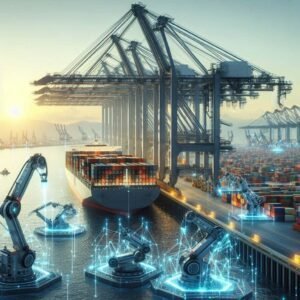The United States relies heavily on its ports for international trade, commerce, and economic growth. However, labor disputes and protests by port workers have significantly disrupted the flow of goods, leading to far-reaching consequences. The underlying reason for these protests is the ports’ shift towards full automation, threatening the jobs of union workers.
Economic Consequences
Supply chain disruptions can delay cargo shipments, causing ripple effects throughout the supply chain. This can lead to shortages, increased costs, and lost revenue for businesses. According to the National Retail Federation, a single day of port disruptions can cost the US economy up to $1 billion.
Social Implications
Delays and shortages can drive up prices for everyday essentials, affecting low-income families disproportionately. Food and medicine shortages can lead to health concerns, particularly in rural or underserved areas. Community businesses, tourism, and development projects can also be impacted.
National Security Concerns
Ports are critical infrastructure, and disruptions can compromise national security. Delays in cargo inspections can increase the risk of contraband and security threats. Emergency response efforts can be hindered by protests, putting lives at risk.
The Automation Threat
The primary driver of these protests is the ports’ transition to automation. Union workers fear that machines will replace them, leading to job losses and diminished bargaining power. Similar trends are seen in various industries, such as toll booth workers losing jobs to EZ-Pass automation, Amazon’s automation replacing 1,300 warehouse workers, and self-driving trucks threatening millions of truck drivers’ jobs.
Los Angeles Port Embraces Automation Amidst Industry Concerns
The Los Angeles port is partially automated, with three of its 12 terminals using some degree of automation ¹. One of these terminals, TraPac’s container terminal, is actually one of the most fully automated and highly integrated container terminals in the world ². It uses automated horizontal transport, automated stacking cranes, and automated rail-mounted gantry cranes to streamline its operations.
However, a recent study by the UCLA Labor Center found that industry stakeholders, including terminal operators and labor representatives, questioned the immediate benefits of increased automation ¹. They noted that automation may not necessarily lead to increased productivity, safety, or cost savings. In fact, there are concerns that automation could pose safety risks for workers, lead to increased workplace surveillance, and have negative impacts on the harbor community.
Automated Trucks: Safety Concerns
The introduction of automated trucks carrying goods into the US poses significant safety risks. While proponents argue that self-driving trucks will reduce human error and enhance efficiency, the potential consequences of system failure are catastrophic. Faulty sensors or software glitches could lead to accidents, and with no human driver to intervene, the situation could quickly spiral out of control. The risks are particularly acute during inclement weather conditions, such as snow or heavy rain, where sensor reliability may be compromised.
Mitigating the Effects of Automation
Retraining programs, education and training, social safety nets, and basic income guarantees are necessary to mitigate the effects of automation. Effective leadership is crucial in addressing port worker protests and disruptions.
The President’s Role
The President plays a vital role in balancing stakeholder interests, ensuring national security, and promoting economic growth. However, concerns about President Biden’s age and health have raised questions about his ability to effectively manage the situation.
In the pass, President George W. Bush’s intervention in the 2002 West Coast Port Lockout is a prime example of how presidential action can resolve labor disputes and ensure national economic stability. In 2002, a labor dispute between the International Longshore and Warehouse Union (ILWU) and the Pacific Maritime Association (PMA) led to a 10-day lockout of West Coast ports, halting cargo shipments and causing significant economic disruption.
Bush invoked the Taft-Hartley Act, issuing an executive order to create a board of inquiry to investigate the dispute. This move helped restart negotiations, end the lockout, and restore port operations. The intervention led to a successful agreement, resolving the dispute and ensuring continued port operation.
This example highlights the importance of:
– *Proactive Leadership*: Addressing labor disputes before they escalate
– *Collaboration*: Government, labor, and industry stakeholders working together
– *Swift Action*: Mitigating economic disruption
The Taft-Hartley Act has been invoked in other instances, too. Recently, the U.S. Chamber of Commerce asked President Biden to use the Act to order striking workers back to work during the East Coast and Gulf ports strike. However, Biden declined, stating his support for collective bargaining and American workers ¹.
Moving Forward
The US port worker protests serve as a stark reminder of the complex challenges posed by automation and the urgent need for effective leadership. As the nation’s ports continue to modernize, the impact on union workers, local communities, and the broader economy cannot be overstated. The protests highlight the delicate balance between technological progress and social responsibility.
The path forward requires a multifaceted approach that prioritizes:
1. Proactive leadership: Addressing labor disputes before they escalate.
2. Collaboration: Fostering constructive dialogue between government, labor, and industry stakeholders.
3. Investment in worker retraining programs: Equipping workers with skills for an automated future.
4. Social safety nets: Supporting workers affected by automation.
5. Bipartisan legislation: Modernizing port infrastructure and labor reforms.
The next administration must recognize the gravity of these challenges and seize the opportunity to shape a sustainable future for America’s ports. By doing so, the US can mitigate the impact of automation, ensure national economic stability, and maintain its position as a global trade leader.
Ultimately, the US port worker protests symbolize a broader national conversation about the future of work, economic inequality, and social justice. As the nation navigates this critical juncture, it is imperative that policymakers, industry leaders, and community stakeholders work together to create a more equitable and resilient future for all.

References:
– National Retail Federation
– International Longshore and Warehouse Union
– US Department of Labor
– Maritime Administration (MARAD)
– The New York Times
– Bloomberg
– Forbes
– McKinsey Global Institute
Moïse Garçon
The post The Devastating Impact of US Port Worker Protests: A Fight Against Automation appeared first on Transparansmm.

